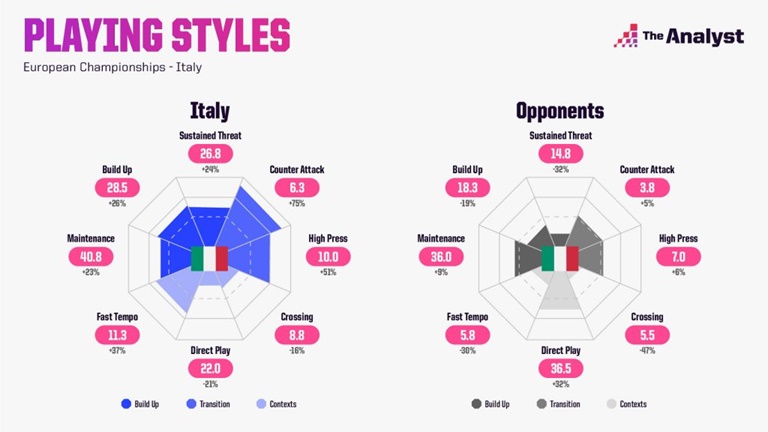AI in Pro Sport: Laying the Groundwork

Even advocates of artificial intelligence (AI) will acknowledge that the concept has endured some ‘false starts’ over the years. However, the past decade has brought a transformation in how AI is perceived in sport -- with the clubs, leagues, organizations and businesses that underpin the industry discovering the innovations that can emerge through the simulation of human intelligence in machines.
“Members of the public rely on this technology every day, and we take it for granted,” says Dr. Patrick Lucey, chief scientist at sports data and analytics provider Stats Perform.
“The availability of data these days is one big difference that has driven AI adoption. There is also a greater appreciation of AI, and the return on investment is there to see via objective measures. It also helps that AI can be applied across all business segments.”
Barriers to Adoption
AI is fueled by crunching swathes of data via iterative processing and algorithms that allow software platforms to identify patterns and predict future outcomes. So, it follows that increasing volumes of data being collected and analyzed in the sports industry in recent years have refined such processes, generating more accurate results and bottom-line benefits.
However, given its definition, it is hardly surprising that AI has also been a difficult notion to grasp for many, especially given how it is often used interchangeably with ‘machine learning’ – a strand of AI that focuses on how computers can imitate the way that humans learn.
This barrier to adoption, though, has slowly evaporated as clubs and franchises have gradually learned to gauge the real-life results from an idea that many initially considered to be abstract.
“When terms like AI and ‘data science’ were first being bandied around, I was one of those who didn’t understand the value of it,” says Ben Mackriell, VP data, AI and pro products at Stats Perform.
“But now there is a greater level of understanding in the market in general that AI is simply a mechanism that enables better experiences, with the core ingredient being data. The challenge is to make AI consumable and break down some of the myths. The process is complex, but the output doesn’t have to be complex.”
Journey of Understanding
Sports clubs have been on this journey of understanding how deploying AI can ultimately improve results – and there is certainly no turning back now. From a performance perspective, more than 350 clubs across various sports rely on Stats Perform’s data and technology services, of which AI is a central component.
Stats Perform was the first company to offer player tracking technology in basketball more than a decade ago. It is now unthinkable for a team in the NBA – as well as any other leading league – not to have analysts on the payroll. “It is an area that has grown exponentially over the past 10 years,” Mackriell adds. “Most Premier League clubs had one or two analysts a decade ago. Now, it is common for them to have more than 10 people working across multiple aspects data analytics.
“Clubs are hiring data engineers now – and you would not have seen that even just three years ago.”
Vivid Illustration
During this summer’s delayed UEFA Euro 2020 soccer tournament, Stats Perform presented a vivid illustration of how “consumable” its AI capabilities can be for fans across Europe and beyond with its Euros Prediction model. Through Stats Perform’s public-facing digital platform, “The Analyst,’’ the model estimated the probability of each match outcome by using a series of inputs that ranged from historical team and player performances to betting market odds and team rankings.
“Hundreds of thousands of scenarios were being crunched every time a goal went in,” Mackriell says. For clubs though, AI-driven predictive modelling can provide insights that delve even deeper. Stats Perform’s “Playing Styles’’ framework, for example, takes into consideration numerous events and factors to determine a team’s tendencies. Eight playing styles are put under the microscope, from build-up play to counter attacks.
Such data-based insights can then be used to identify the roles of individual players within each style and also analyze– crucially, in an age of sky-high salaries and transfer fees – how a possible new signing would slot into the existing team system. “Every action and phase on the field is broken down,” Mackriell adds. “Every action on the pitch can be quantified in terms of how likely it is to lead to a goal, and you can see how individuals contribute towards a goal-scoring opportunity.
This supports decision-making and assists in terms of scouting and investing in the team. “One of the most common questions we are asked by a club is: ‘How will this player’s skills translate into our team and league.’ That is where teams are seeing a return on investment with AI.”
Moneyball
For sports clubs and franchises, AI is ‘Moneyball’ 2.0 – using data to introduce layers of predictive insights that can help them make sound business decisions. Most importantly, it is about focusing on solving a problem at the outset. “We spend time with clubs across multiple sports to identify the problems they are trying to solve,” Mackriell says. “This problem-solving approach is how we deploy AI as a company, rather than just trying to bring together AI tech and data.”
Given increasing levels of data coverage, the results for clubs and franchises worldwide will become increasingly sophisticated, according to Lucey. “Sport has been a slow adopter as clubs are understandably private about how they operate,” he says. “Like anything in sport, though, once there is success, there is a snowball effect.”





